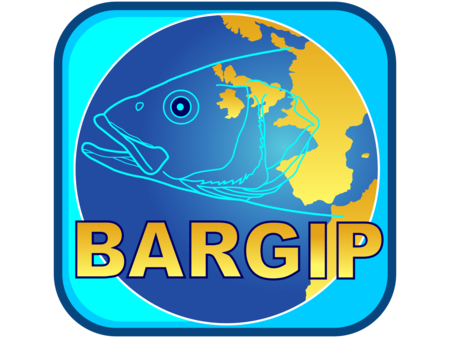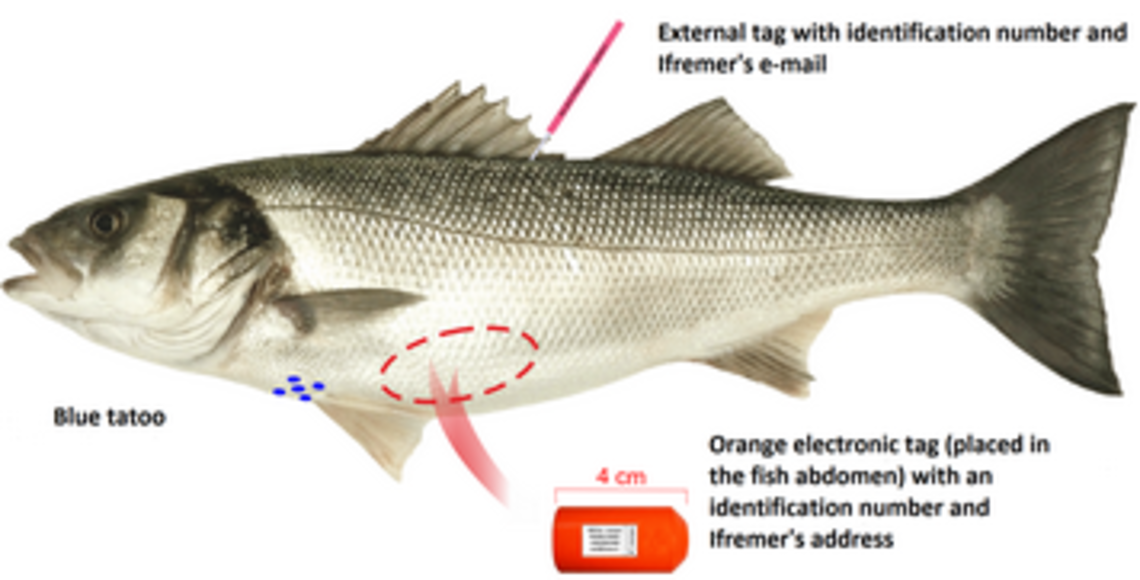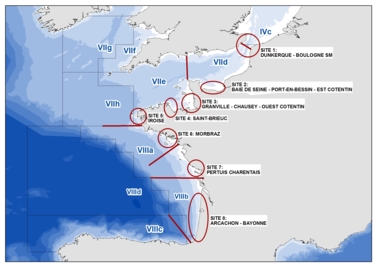Marking of adults with electronic recording tags
Contents
- Why mark adult sea bass ?
- Recognize a marked sea bass or an electronic tag beached on the shore
- Win a reward for returning a marked fish or an electronic tag
- Experiments conducted in partnership with the Natural Marine Park of the Iroise Sea
- Large scale marking of the Bargip project
- The marking project of our British partners
Why mark adult sea bass ?
For a long time, scientists have been marking and releasing fish to study their characteristics (e.g. growth), their behaviour, movements and migratory routes. The first marking dates back to the 17th century (according to Izaak Angler, 1683 « The Complete Angler ») and have shown that salmon return to their native river after having been to sea.
(click on the picture)
Conventional external marking has always, and still is, very commonly used, providing significant information. However, even if we know where and when the fish was marked and recaptured, this method does not provide information on the events occurring between marking and re-capturing. For example, if a fish has been marked in a summer feeding zone and re-fished in the same zone a year later, we cannot know if the fish migrated in winter to reproduce or if it effectively remained in the same zone throughout the year.
At the end of the 20th century, new technologies appeared and notably that of electronic tagging which has not ceased to improve since. Data storage tags also called archival tags provide parameters of the environment experienced by the fish at pre-programmed frequencies. Thanks to the development of adapted numerical models, these data confronted with environmental ones allow the reconstruction of the probable trajectories of fish between the time it was marked and released and the time of recapture.
This is the type of technology used for sea bass with the aim of better understanding migratory routes of adult fish and therefore identifying possible subpopulations which would represent as many management entities.
Indeed, the four stocks currently identified by ICES (International Council for the Exploration of the Sea) were defined, due to lack of sufficient data, on purely pragmatic criteria. They are considered as independent entities, but it has not been scientifically proven yet.
(click on the map)
Recognize a marked sea bass or an electronic tag beached on the shore.
Marked sea bass may be identified thanks to :
- An electronic tag placed in the abdominal cavity marked by an identity number and contacts at Ifremer. The electronic tag is equipped with a float which drifts if lost by the fish (natural death or not). Tags found along the coast contain potentially precious information and should be returned.
- An external pink-coloured tag at the back of the dorsal fin marked by an Ifremer identity number and contact.
- The presence of blue marks on the ventral side in front of pectoral fins.
- The presence of a scar on the ventral side
It should be noted that the last 3 criteria may have been attenuated or even erased if the fish has been free for a long period after the release.
Win a reward for returning a marked fish or an electronic tag
If you fish or buy a tagged fish or if you find an electronic tag on the shore :
- Keep the fish in the fridge or a standard freezer (-18°C) and note any useful information (see on-line form)
- Contact us :
◦ by filling in the on-line form
◦ by phone on : +33 (0)6 85 62 76 88
◦ by e-mail : merl@ifremer.fr
A reward of 100 € will be offered if you return the fish and the electronic tag as well as the information (on-line form) concerning the capture.
A reward of 50 € will be offered for the return of an electronic tag with relevant information.
You will also participate in a draw at the end of the experiment for a potential extra prize of 1000€.
These marking experiments cannot work without your help : We're counting on you !
Experiments conducted in partnership with the Natural Marine Park of the Iroise Sea
Experiments were conducted between 2010 and 2012 in partnership with the Natural Marine Park of the Iroise sea (Parc Naturel Marin d’Iroise) during which a total of 246 adult bass were marked with archival tags (look at the video of a tagging operation). Different protocols were tested with a rate of recapture varying from ~14% (2010) to ~8% (2011) with time at liberty sufficiently long (12 to 18 months) to analyse migratory routes.
These operations have provided new knowledge on the sea bass of the Iroise Sea. A numerical model has been developed to reconstruct individual migratory routes from temperature and pressure data recorded in the archival tag. The results of the analyses of the returned tags show that some individuals undertake winter migration (reproduction) over great distances before returning to the Iroise sea the following year (fidelity to feeding areas). Different winter migratory strategies are observed, mainly in the Bay of Biscay but also towards the Celtic sea. These first results were presented at the annual ICES conference in 2013 and will be shortly published.
Large scale marking of the Bargip project
To identify the main types of migratory strategies and the associated sub populations in the Atlantic, Channel and North Sea, the marking of 1200 adult bass is planned over 8 different sites. One of the main objectives being to contribute to distinguish possible sub populations, the marking sites will be positioned around the supposed limits between stocks.
These limits are situated, according to authors and authorities in charge of stock management :
- between the North Sea and the Eastern Channel : site (1) Boulogne sur Mer/Dunkerque
- between the Eastern Channel and Western Channel : Seine Bay/Port en Bessin/east Cotentin (2) and west Cotentin/Granville/Chausey (3),
- between the western Channel and south Brittany : Bay of St Brieuc (4), the Iroise sea (5) and the Mor Braz area (6)
- between south Brittany and the north of the Bay of Biscay : Mor Braz (6) and Pertuis Charentais (7)
- near the Gironde, between north and south Bay of Biscay : Pertuis Charentais (7) and Arcachon/Bayonne (8)
(click on the map)
The aim is to mark 150 individuals on each of the 8 identified sites which we hope will result in 10-20 recaptures per site. We cannot however exclude significant differences in recapture according to each site.
600 tags will be deployed in 2014 on 4 sites (2 in the Channel/North Sea and 2 in the Bay of Biscay). In 2015, there will be 600 more tags on 4 sites not covered in 2014.
In total, 1200 tags will be deployed in 2014-2015 on the 8 identified sites.
Analysis of the results and synthesis of data will be conducted in 2016-2017, the time necessary to gather data from recaptures of the last year of marking, i.e. 2015.
General coordination and supervision of operations will be ensured by Ifremer, Operations will involve local professional fishermen for :
- capture of live fish, in perfect condition to support the tagging
- providing a support ship for tagging operations (surgery to implant electronic tags) and connected work (biometry, removal of scales and piece of fin for subsequent age estimation and genetic studies).
The marking teams at Ifremer are trained to perform experiments on live animals and authorisation project was requested to the Ministry of Research at the end of 2013.
The marking project of our British partners
CEFAS is currently conducting a project on sea bass including both conventional and electronic tagging.
If you recapture a sea bass marked by CEFAS or any other British archival tag, please fill the electronic form









